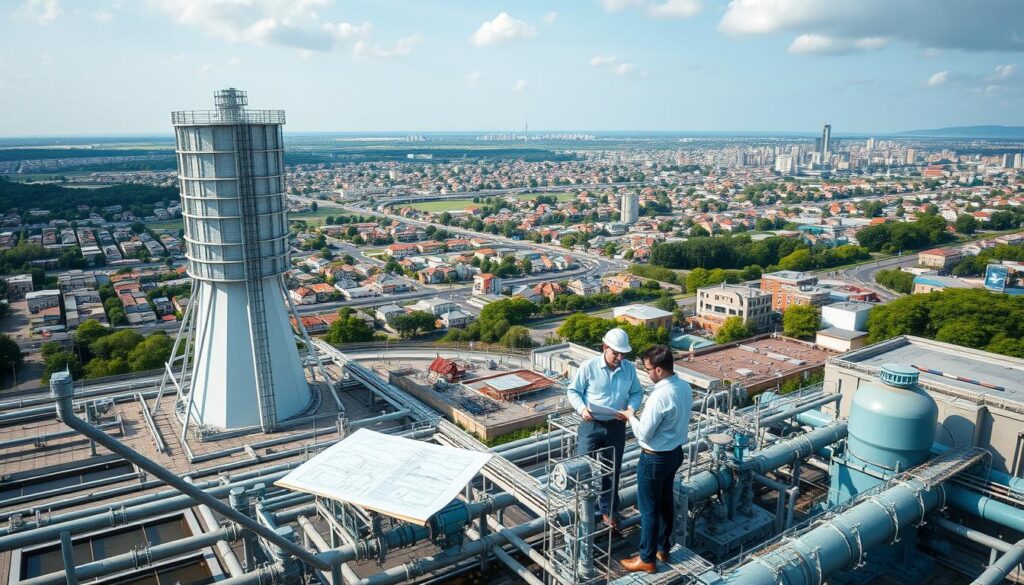Can a community thrive without a reliable water distribution system? The answer lies in understanding the complexities of creating a robust infrastructure that ensures sustainable water management. A well-designed system is crucial for meeting the demands of a growing population while maintaining the quality and quantity of this vital resource.
Designing a robust water infrastructure involves careful planning, analysis, and optimization of various factors, including sources, demand, quality, distribution, storage, and protection. According to research, a systematic approach is necessary to ensure reliability and efficiency in water network design, taking into account uncertainties and potential future challenges.
Key Takeaways
- A robust water infrastructure is crucial for sustainable water management.
- Careful planning and analysis are necessary for reliable water distribution.
- Optimization techniques, such as stochastic programming and evolutionary algorithms, can enhance the robustness of the system.
- A well-designed water supply system ensures the quality and quantity of water.
- Research supports the use of systematic approaches for efficient water network design.
Understanding Water Supply Networks
Understanding the intricacies of water supply systems is essential for engineers and urban planners tasked with designing effective water distribution networks. A well-designed water supply network is crucial for delivering clean water to consumers while minimizing losses and ensuring sustainability.
Definition and Purpose
A water supply network is a complex system of infrastructure designed to collect, treat, and distribute water to meet the needs of a community. The primary purpose of such a network is to provide a reliable and safe supply of water for various uses, including drinking, sanitation, and industrial applications.
The effectiveness of a water supply network depends on several factors, including its design, operation, and maintenance. A well-designed network can significantly reduce water losses, lower energy consumption, and improve overall water quality.
Types of Water Supply Systems
Water supply systems can be categorized based on their source and treatment processes. The main types include:
- Surface water systems, which draw water from rivers, lakes, and reservoirs.
- Groundwater systems, which use wells and aquifers as their source.
- Reclaimed water systems, which treat and reuse wastewater for non-potable purposes.
Each type of system has its advantages and disadvantages. For instance, surface water systems can be more susceptible to contamination but are often less expensive to develop than groundwater systems. Reclaimed water systems offer a sustainable alternative for non-potable uses, reducing the demand on potable water sources.
| Type of Water Supply System | Advantages | Disadvantages |
|---|---|---|
| Surface Water | Can supply large quantities, relatively low cost | Susceptible to contamination, seasonal variability |
| Groundwater | Generally of high quality, less susceptible to seasonal changes | Can be expensive to develop, risk of over-extraction |
| Reclaimed Water | Sustainable, reduces demand on potable water | Limited to non-potable uses, requires advanced treatment |
Understanding these different types of water supply systems and their characteristics is crucial for designing an effective water distribution system layout that meets the needs of the community while ensuring sustainability and efficiency.
In urban water infrastructure design, considering the type of water supply system is vital for creating a resilient and adaptable network that can meet future demands and challenges.
Key Factors Influencing Design
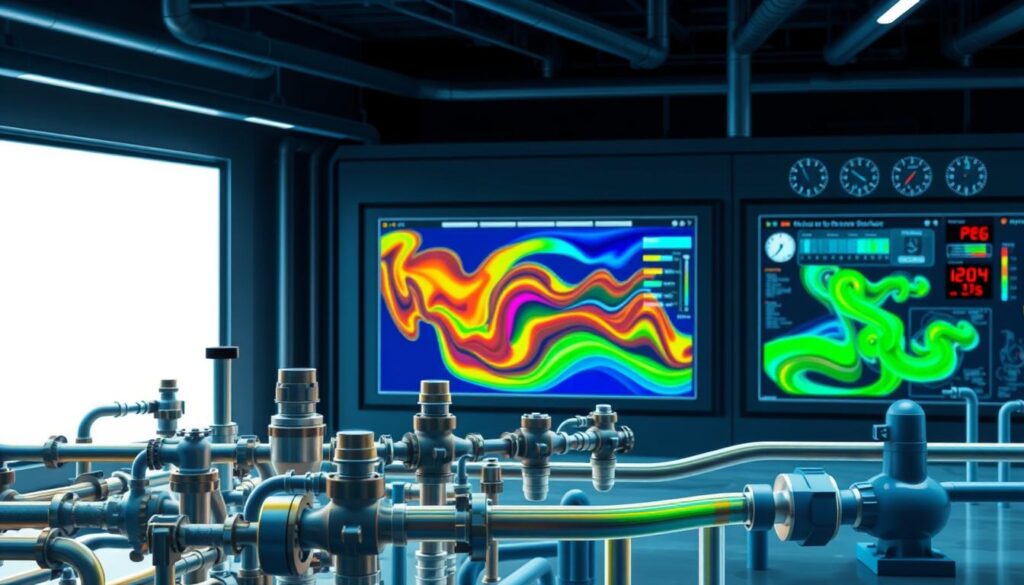
Several key factors play a crucial role in the design of a robust water supply network. These factors are fundamental in ensuring that the network is efficient, reliable, and capable of meeting the demands of the served population.
Population Density
Population density is a critical factor in determining the size and capacity of a water supply network. Areas with high population densities require more complex and extensive networks to ensure that every household and business has access to clean water. Hydraulic modeling for water networks is essential in these cases to optimize the distribution system and manage pressure effectively.
Geography and Topography
The geography and topography of an area significantly influence the design of a water supply network. Regions with varied elevations and landscapes require careful planning to ensure that water is distributed evenly and that the system can withstand natural challenges such as floods or landslides. Topographic analysis helps in identifying the most suitable routes for pipelines and the optimal locations for water storage facilities.
Climate Considerations
Climate is another vital factor that affects the design of water supply networks. Areas prone to droughts or extreme weather conditions need systems that are resilient and adaptable. For instance, in regions with low rainfall, water conservation measures and efficient distribution systems are crucial. Water network optimization techniques can help in minimizing losses and ensuring a steady supply during adverse conditions.
In conclusion, the design of a water supply network is a complex task that requires a thorough understanding of various influencing factors. By considering population density, geography, topography, and climate, designers can create systems that are not only efficient but also sustainable and reliable.
Components of a Water Supply Network
Designing a robust water supply network requires a comprehensive understanding of its key components. A well-functioning water supply network is crucial for delivering clean water to consumers, and its components work together to ensure a reliable and sustainable water supply.
Water Sources
The first critical component of a water supply network is the water source. Water sources can be categorized into surface water (rivers, lakes, reservoirs) and groundwater (aquifers). The choice of water source depends on various factors including availability, quality, and cost. Sustainable water supply systems often incorporate a combination of these sources to ensure resilience against droughts and other disruptions.
Distribution Pipelines
Distribution pipelines are the backbone of a water supply network, transporting water from the treatment plant to consumers. The material and diameter of these pipes are critical for minimizing leaks and ensuring water quality. Modern water network simulation software can model pipeline behavior under various conditions, helping engineers design more efficient systems.
Pumps and Valves
Pumps and valves are essential for controlling water flow and pressure within the network. Pumps are used to move water through the system, overcoming elevation changes and friction losses, while valves regulate flow and isolate sections of the network for maintenance. Proper selection and operation of these components are vital for the network’s efficiency and reliability.
Storage Facilities
Storage facilities, such as tanks and reservoirs, play a crucial role in balancing water supply and demand. They store water during periods of low consumption and release it during peak demand, helping to maintain consistent pressure throughout the network. The design and management of these facilities are critical for ensuring a reliable water supply.
| Component | Function | Importance |
|---|---|---|
| Water Sources | Provide raw water for treatment | High |
| Distribution Pipelines | Transport treated water to consumers | High |
| Pumps and Valves | Control water flow and pressure | High |
| Storage Facilities | Balance supply and demand | High |
In conclusion, each component of a water supply network is vital for its overall performance. By understanding and optimizing these components, engineers can design more sustainable and resilient water supply systems. The use of advanced tools like water network simulation software further enhances the ability to model and manage these complex systems effectively.
Designing for Efficiency
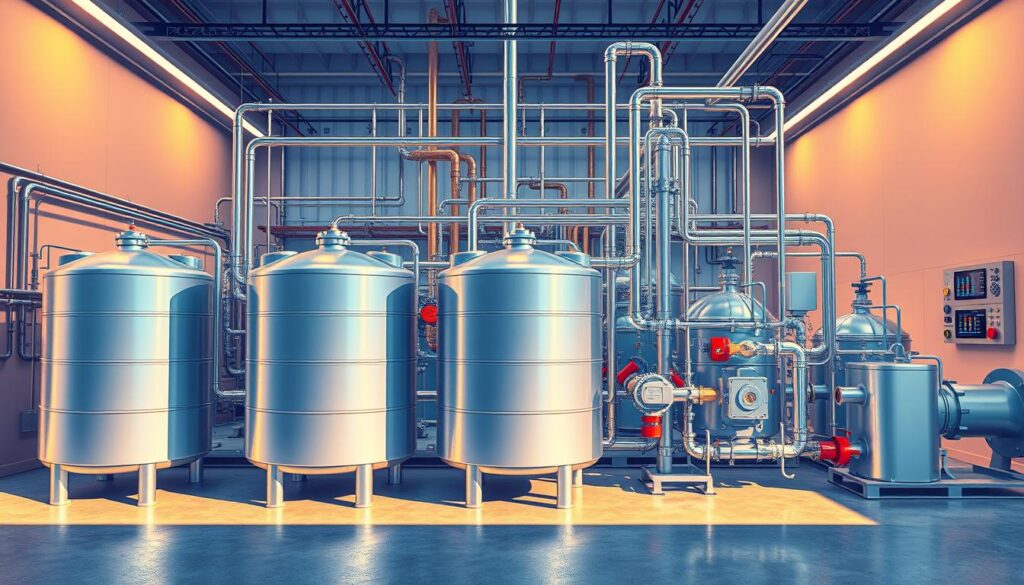
Water management engineering plays a vital role in designing efficient water supply networks. Efficient design is crucial for minimizing losses and ensuring consistent water delivery to meet the demands of a growing population.
To achieve this efficiency, several key strategies are employed, including hydraulic modeling, pressure management, and leak detection. These strategies are integral to optimizing network performance.
Hydraulic Modeling
Hydraulic modeling is a critical component of water supply network design. It involves creating detailed models of the network to simulate various scenarios, including peak demand periods and potential failure points. This allows engineers to identify potential issues before they become major problems.
By utilizing hydraulic modeling, engineers can optimize pipe sizing, pump placement, and valve configuration. This not only improves the efficiency of the network but also reduces energy consumption and operational costs. For more information on optimizing water distribution networks, visit McClure Vision.
Pressure Management
Pressure management is another crucial aspect of designing an efficient water supply network. Proper pressure management helps prevent pipe bursts and reduces leakage. It involves installing pressure-reducing valves and monitoring pressure levels throughout the network.
Effective pressure management also enhances the overall reliability of the network. By maintaining optimal pressure levels, the risk of pipe failures is minimized, ensuring a consistent supply of water to consumers.
Leak Detection Strategies
Leak detection is a vital component of water management engineering. Leaks can lead to significant water loss, increased energy consumption, and higher operational costs. Implementing advanced leak detection strategies is essential for minimizing these losses.
Modern leak detection techniques include the use of acoustic sensors and advanced data analytics. These technologies enable utilities to identify leaks quickly and accurately, allowing for prompt repair and minimizing water loss. For insights into civil engineering practices in project management, including water supply networks, refer to World Civil Society.
Water Quality Considerations
The design of a water supply network must prioritize water quality to safeguard public health. Ensuring that water is safe for consumption involves several critical components, including testing, treatment, adherence to regulatory standards, and effective monitoring systems.
Testing and Treatment
Water testing is fundamental in identifying contaminants and assessing water quality. Regular testing helps in detecting issues early, allowing for timely intervention. Treatment processes, such as filtration, disinfection, and sedimentation, are crucial in removing or reducing contaminants to acceptable levels. According to de Faria et al. (2009), effective treatment processes are vital in ensuring that water meets or exceeds regulatory standards.
“The quality of water is a critical factor in public health, and its protection is a fundamental responsibility of water supply agencies.” This underscores the importance of robust testing and treatment protocols in water supply network design.
Regulatory Standards
Regulatory standards play a pivotal role in defining the acceptable limits for various contaminants in water. Compliance with these standards is not only mandatory but also essential for ensuring the safety of the water supply. In the United States, the Environmental Protection Agency (EPA) sets these standards under the Safe Drinking Water Act.
- Maximum Contaminant Levels (MCLs) are established for various substances.
- Water supply networks must adhere to these MCLs to ensure compliance.
- Regular monitoring and reporting are required to demonstrate compliance.
Monitoring Systems
Effective monitoring systems are crucial for detecting changes in water quality and identifying potential issues before they become significant problems. Modern monitoring systems utilize advanced technologies, including sensors and real-time data analytics, to provide continuous oversight of water quality.
Hydraulic modeling for water networks also plays a significant role in maintaining water quality by predicting flow patterns and pressure within the network, helping to identify areas where water quality might be compromised.
In conclusion, water quality considerations are integral to the design of a robust water supply network. By focusing on testing and treatment, adhering to regulatory standards, and implementing effective monitoring systems, water supply networks can ensure the delivery of safe and clean water to consumers.
Planning for Future Growth
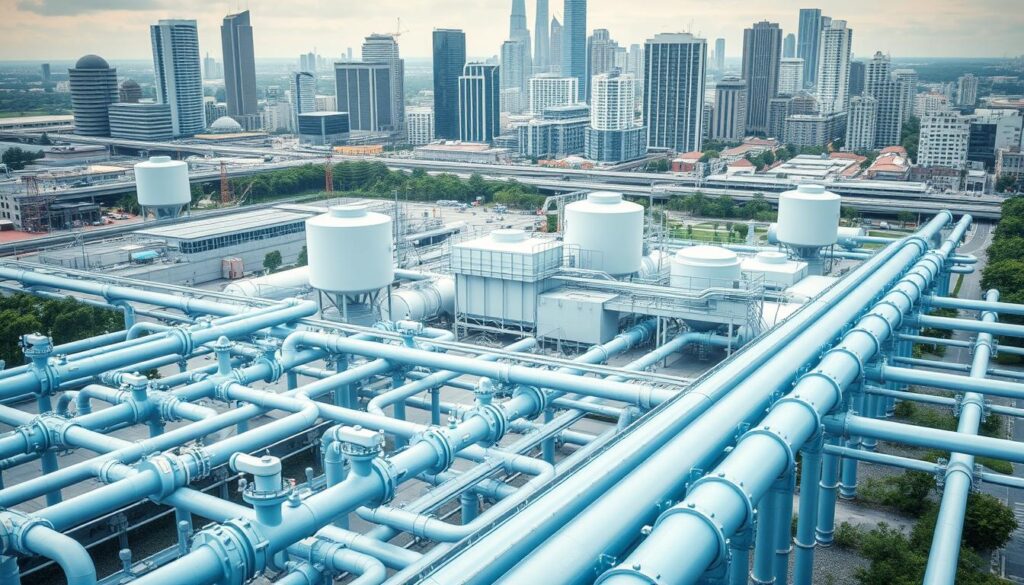
As urban populations continue to grow, designing water supply networks that can adapt to future demands is essential. This involves incorporating several key elements into the design process to ensure that the network remains efficient and effective over time.
Scalability Principles
Scalability is critical in urban water infrastructure design. It involves designing the network in a way that allows for easy expansion or modification as the demand for water changes. This can be achieved by:
- Using modular designs that can be easily expanded
- Incorporating flexible piping systems
- Implementing advanced technologies that can be upgraded or modified as needed
By incorporating scalability principles, water supply networks can be optimized to meet future demands without requiring significant redesign or reconstruction.
Community Engagement
Community engagement is another vital aspect of planning for future growth. It involves working closely with local stakeholders to understand their needs and concerns. This can be achieved through:
- Public workshops and meetings
- Surveys and feedback mechanisms
- Collaboration with local government and organizations
Effective community engagement helps ensure that the water supply network is designed to meet the needs of the local population, both now and in the future.
Environmental Impact Assessments
Conducting thorough environmental impact assessments is also crucial in planning for future growth. This involves evaluating the potential environmental impacts of the water supply network and implementing measures to mitigate them. Key considerations include:
| Environmental Factor | Potential Impact | Mitigation Measures |
|---|---|---|
| Water Source | Over-extraction of water resources | Implement sustainable water harvesting practices |
| Land Use | Habitat destruction and disruption of ecosystems | Conduct thorough environmental impact assessments and implement measures to minimize habitat disruption |
| Energy Consumption | Increased greenhouse gas emissions | Implement energy-efficient technologies and renewable energy sources |
By considering these factors and implementing mitigation measures, water supply networks can be designed to minimize their environmental footprint and ensure sustainability for future generations.
Geographic Information Systems in Design
GIS technology plays a crucial role in modern water distribution system layout. By integrating spatial data with analytical capabilities, GIS enables designers to create more efficient and sustainable water supply networks.
Mapping Resources
One of the primary applications of GIS in water supply network design is the mapping of resources. This includes identifying potential water sources, mapping existing infrastructure, and analyzing the topography of the area.
Mapping Resources Benefits
- Accurate identification of water sources
- Detailed mapping of existing infrastructure
- Topographical analysis for optimal network design
Analyzing Data
GIS is not only used for mapping but also for analyzing complex data related to water supply networks. By leveraging GIS tools, designers can simulate various scenarios, predict potential issues, and optimize the network design.
Data Analysis with GIS
| Analysis Type | Description | Benefits |
|---|---|---|
| Hydraulic Modeling | Simulates water flow and pressure | Optimizes network performance |
| Network Analysis | Analyzes connectivity and flow | Identifies potential bottlenecks |
| Demand Analysis | Predicts water demand patterns | Ensures adequate supply |
Visualization Techniques
GIS also offers powerful visualization techniques that help in communicating complex design plans to stakeholders. By creating detailed maps and 3D models, designers can better illustrate their proposals.
The integration of GIS with water network simulation software further enhances the design process. This combination allows for more accurate modeling and simulation of water supply networks, leading to more efficient and resilient designs.
Sustainability Practices in Water Supply

Sustainability in water supply network design encompasses various practices, including the use of renewable energy and sustainable materials. As the world moves towards more environmentally friendly solutions, the importance of incorporating sustainability into water management engineering cannot be overstated.
Renewable Energy Options
The use of renewable energy options is a critical component of sustainable water supply systems. Solar and wind power can be harnessed to operate pumps and other equipment necessary for water distribution. This not only reduces the carbon footprint of water supply networks but also decreases operational costs over time.
For instance, solar-powered pumping systems can be particularly effective in regions with abundant sunlight, providing a reliable and sustainable means of water supply.
Water Conservation Measures
Water conservation is another vital aspect of sustainability in water supply. Implementing measures such as leak detection systems and water-saving appliances can significantly reduce water waste. Moreover, public awareness campaigns can educate consumers on the importance of water conservation, further enhancing the sustainability of water supply systems.
Key Water Conservation Measures:
- Leak detection and repair
- Installation of low-flow fixtures
- Public education campaigns
Sustainable Materials
The choice of materials used in water supply infrastructure also plays a significant role in sustainability. Using materials that are durable, recyclable, and have a low environmental impact can reduce the overall environmental footprint of water supply networks.
| Material | Durability | Environmental Impact |
|---|---|---|
| Ductile Iron | High | Moderate |
| PVC | High | Low |
| Concrete | High | High |
By incorporating renewable energy options, water conservation measures, and sustainable materials, water supply networks can significantly enhance their sustainability. This not only benefits the environment but also contributes to the long-term viability of water supply systems.
Financial Planning for Water Projects
Comprehensive financial planning is essential for the effective management of water supply projects. It involves a thorough analysis of costs, funding opportunities, and economic viability to ensure the project’s success.
Effective financial planning for water supply projects requires a multi-faceted approach, including budgeting and costing to understand the financial implications of the project. According to research, thorough financial planning is crucial for the viability of water projects (Housh M, Ostfeld A, Shamir U, 2011).
Budgeting and Costing
Budgeting and costing are fundamental components of financial planning. They involve estimating the total cost of the project, including infrastructure, equipment, and operational expenses. Accurate budgeting helps in allocating resources efficiently and avoiding cost overruns.
For instance, in managing a civil engineering project, budgeting and costing play a critical role in ensuring that the project stays within financial constraints.
Funding Opportunities
Identifying funding opportunities is another critical aspect of financial planning for water supply projects. This can include government grants, loans, and public-private partnerships. Exploring various funding sources can help in securing the necessary funds to complete the project.
Economic Analysis of Water Supply
Conducting an economic analysis is vital to assess the financial viability of water supply projects. It involves evaluating the costs and benefits of the project, including the potential return on investment. This analysis helps in making informed decisions about the project’s feasibility.
Economic analysis also considers the long-term sustainability of the water supply system, ensuring that it remains financially viable over its lifespan.
Risk Management Strategies

Designing a robust water supply network requires comprehensive risk management. This involves understanding potential hazards and developing strategies to mitigate them, ensuring the network’s resilience and reliability.
Identifying Potential Hazards
Identifying potential hazards is the first step in risk management. These hazards can range from natural disasters like earthquakes and floods to human-induced risks such as contamination and infrastructure failure.
A thorough risk assessment involves analyzing historical data, environmental conditions, and the network’s infrastructure to pinpoint vulnerabilities. For instance, older pipes may be more susceptible to leaks and bursts, while areas with high population growth may face increased demand pressures.
Emergency Preparedness Plans
Developing emergency preparedness plans is crucial for responding effectively to potential hazards. These plans outline procedures for emergency situations, ensuring that the water supply network can quickly recover from disruptions.
Key components of emergency preparedness plans include:
- Identifying emergency scenarios and their potential impact
- Establishing communication protocols for stakeholders
- Outlining response strategies and resource allocation
- Conducting regular drills and training exercises
| Risk Category | Hazard Examples | Mitigation Strategies |
|---|---|---|
| Natural Disasters | Earthquakes, Floods | Reinforced infrastructure, Flood protection measures |
| Human-Induced Risks | Contamination, Infrastructure failure | Regular maintenance, Water quality monitoring |
| Operational Risks | Equipment failure, Power outages | Backup systems, Regular maintenance |
By integrating risk management strategies into water supply network design, utilities can enhance the resilience and sustainability of their systems, ensuring a reliable water supply for communities.
Community Involvement in Design
Designing a robust water supply network requires more than just technical expertise; it demands active community involvement. By engaging with the community, designers can better understand the needs and concerns of the people they are serving.
Stakeholder Engagement
Stakeholder engagement is a critical component of community involvement. It involves identifying and working with individuals and groups who have a vested interest in the water supply network. This can include local residents, businesses, and government agencies. Effective stakeholder engagement can help to build trust and ensure that the design meets the needs of the community. According to research, stakeholder engagement can be facilitated through various means, including public meetings and surveys as outlined in this document.
Public Workshops and Feedback
Public workshops provide a valuable opportunity for community members to learn about the design process and offer their feedback. These workshops can be an effective way to gather input and build support for the project. By incorporating community feedback into the design process, designers can create a water supply network that is more responsive to the needs of the community. This can lead to increased satisfaction and a greater sense of ownership among community members.
Furthermore, public workshops can help to educate the community about the importance of water supply planning and design. By engaging with the community in this way, designers can foster a greater understanding of the complexities involved in creating a reliable and efficient water supply network.
Technological Advancements in Water Supply
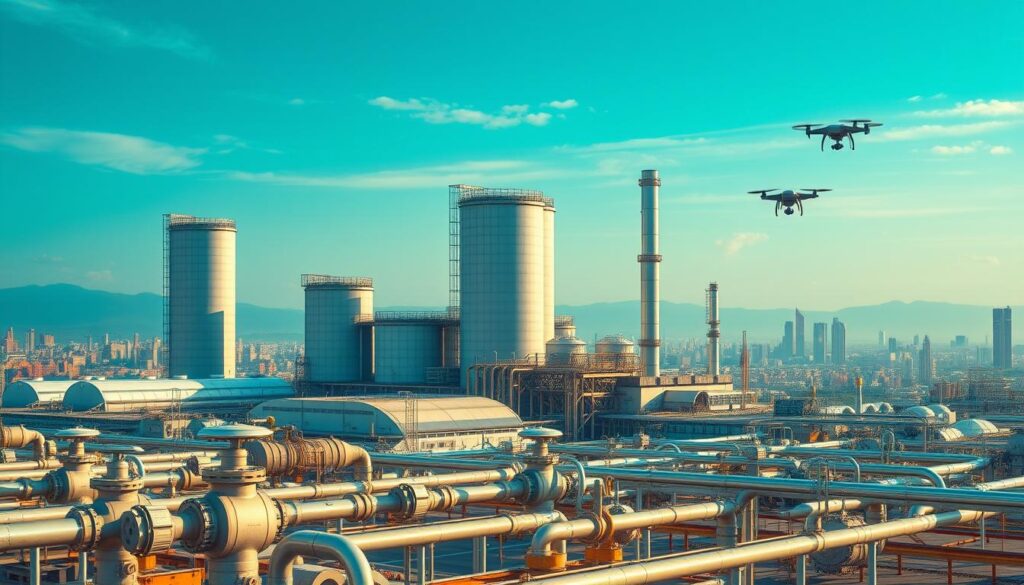
Technological innovations are revolutionizing the design and operation of water supply networks. The integration of advanced technologies is enhancing the efficiency, sustainability, and reliability of these systems.
Smart Water Management Systems
Smart water management systems utilize real-time data and advanced analytics to optimize water distribution and detect potential issues before they become major problems. These systems can significantly reduce water loss and improve the overall resilience of the water supply network.
Key features of smart water management systems include:
- Real-time monitoring of water pressure and flow rates
- Advanced leak detection algorithms
- Predictive maintenance scheduling
IoT in Water Networks
The Internet of Things (IoT) is playing an increasingly important role in water supply networks. IoT devices can be used to monitor water quality, track consumption patterns, and control valves remotely. This technology enables utilities to respond quickly to changes in demand and supply conditions.
The benefits of IoT in water networks include:
- Enhanced monitoring capabilities
- Improved operational efficiency
- Better decision-making through data-driven insights
Data Analytics Applications
Data analytics is being used to analyze large datasets related to water supply networks, providing valuable insights into their operation and performance. By applying advanced analytical techniques, utilities can identify areas for improvement and optimize their systems for better performance.
Applications of data analytics in water supply include:
- Predictive modeling of water demand
- Optimization of pump operations
- Identification of potential pipe failures
Water network simulation software is another critical tool in the design and operation of modern water supply systems. This software allows engineers to model different scenarios, test the resilience of the network under various conditions, and identify potential bottlenecks or areas of improvement.
Legal and Regulatory Framework
The legal and regulatory framework plays a crucial role in shaping the design of water supply networks across the United States. This framework encompasses a range of requirements and standards that designers must adhere to, ensuring that water supply systems are not only effective but also compliant with national and state regulations.
Permitting Processes
One of the critical aspects of the legal and regulatory framework is the permitting process. Obtaining the necessary permits is a prerequisite for the construction and operation of water supply networks. The process involves submitting detailed plans and specifications to the relevant authorities, who then review these documents to ensure compliance with existing regulations.
For instance, the California Water Boards provide comprehensive guidelines and regulations that must be followed. Designers must be aware of these regulations and incorporate them into their design plans.
Compliance with EPA Standards
Another vital component is compliance with standards set by the Environmental Protection Agency (EPA). The EPA sets national standards for drinking water quality, which includes limits on certain contaminants in water. Water supply network designers must ensure that their systems are capable of meeting these standards.
Key aspects of EPA compliance include:
- Regular testing for contaminants
- Implementation of treatment processes to remove or reduce contaminants
- Maintenance of distribution systems to prevent contamination
By adhering to these standards, water supply networks can provide safe drinking water to consumers, thereby protecting public health.
In conclusion, the legal and regulatory framework is a foundational element in the design of water supply networks. By understanding and complying with permitting processes and EPA standards, designers can create systems that are both effective and compliant with regulatory requirements.
Maintenance Practices for Longevity
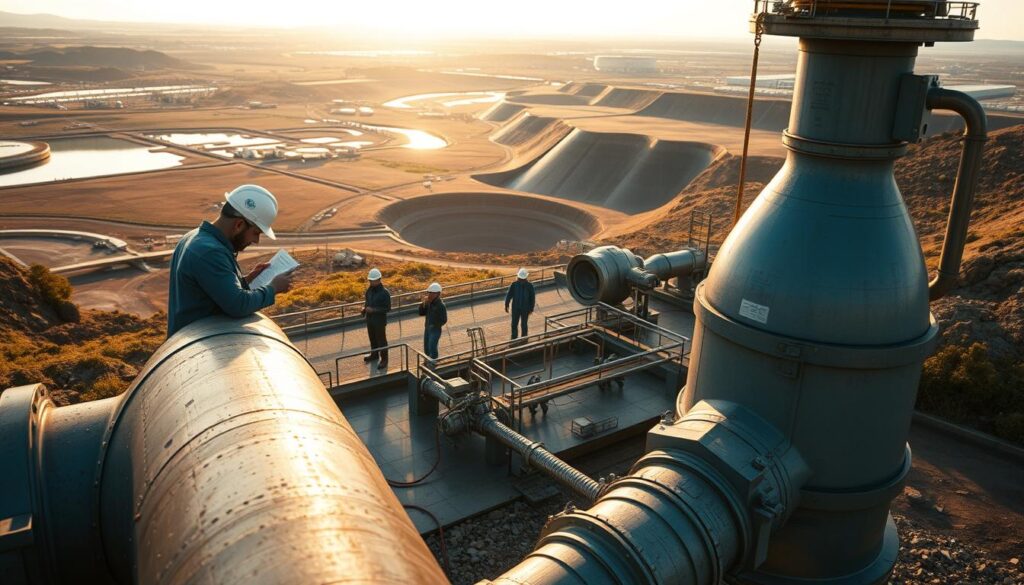
The longevity of water supply networks heavily relies on robust maintenance practices. Effective maintenance ensures that the infrastructure remains in good condition, reducing the likelihood of failures and the need for costly repairs. Water management engineering plays a crucial role in this aspect, as it involves the application of engineering principles to maintain the integrity and functionality of water supply systems.
Routine Inspections
Routine inspections are a critical component of maintenance practices. These inspections help identify potential issues before they become major problems. Some key activities during routine inspections include:
- Checking for signs of wear and tear on pipes and fittings
- Monitoring water quality to detect any contamination
- Inspecting valves and pumps for proper operation
By conducting regular inspections, maintenance teams can address issues promptly, thereby preventing more significant problems from developing.
Asset Management Strategies
Asset management strategies are essential for the long-term sustainability of water supply networks. These strategies involve planning and managing the maintenance and replacement of assets to maximize their lifespan. Key aspects of asset management include:
- Creating a comprehensive inventory of assets
- Prioritizing maintenance based on asset criticality
- Utilizing data analytics to predict asset failures
Effective asset management enables water utilities to optimize their maintenance activities, reduce costs, and improve the overall reliability of the water supply network.
In conclusion, maintaining the longevity of water supply networks requires a combination of routine inspections and robust asset management strategies. By implementing these maintenance practices, water utilities can ensure the continued functionality and efficiency of their infrastructure.
Case Studies of Successful Networks
Case studies of successful water supply networks reveal a range of design approaches tailored to different environments. These studies provide valuable insights into the strategies and solutions that have been effectively implemented in various urban and rural settings.
Urban Projects
Urban water supply networks face unique challenges due to higher population densities and infrastructure complexities. A notable example is the water supply system redesign in Singapore, which incorporated advanced technologies like real-time monitoring and predictive maintenance to enhance efficiency and reliability. According to a study on water supply network design principles, such innovative approaches can significantly improve water supply resilience in urban areas.
The use of Geographic Information Systems (GIS) and hydraulic modeling has been instrumental in optimizing urban water distribution. For instance, cities like New York have utilized GIS to map their water infrastructure, allowing for more precise management and planning.
| City | Design Strategy | Outcome |
|---|---|---|
| Singapore | Advanced real-time monitoring | Enhanced efficiency and reliability |
| New York | GIS mapping for infrastructure | Improved management and planning |
Rural Solutions
Rural areas present different challenges, such as dispersed populations and limited resources. Successful rural water supply projects often focus on sustainability and community involvement. For example, a rural water supply initiative in Australia emphasized community engagement and education to ensure the long-term viability of the water system.
These projects also benefit from innovative technologies that are cost-effective and easy to maintain. Rainwater harvesting systems, for instance, have been successfully implemented in various rural communities worldwide.
- Community engagement and education
- Innovative, cost-effective technologies
- Sustainable practices like rainwater harvesting
By examining these case studies, it becomes clear that successful water supply network design requires a tailored approach that considers the unique characteristics of each area, whether urban or rural.
Conclusion: The Future of Water Supply Network Design
Designing a robust water supply network is crucial for ensuring the health and well-being of communities. As discussed throughout this article, various factors influence the design of such networks, including population density, geography, and climate considerations.
The future of water supply network design lies in integrating innovation and sustainability. This involves leveraging technological advancements, such as smart water management systems and IoT, to create efficient and resilient networks. Research by experts like Zhang W, Bayraksan G, Chung G, and Lansey K emphasizes the importance of sustainable practices in water supply systems.
Key Strategies for Future Development
To achieve sustainable water supply systems, it is essential to implement continuous improvement measures. This includes regular maintenance practices, hydraulic modeling, and pressure management. By adopting these strategies, water utilities can ensure the long-term viability of their networks.
Moving Forward
As the demand for water continues to grow, the need for sustainable water supply systems will become increasingly important. By integrating innovation and sustainability, water utilities can create robust networks that meet the needs of communities while minimizing environmental impact.
